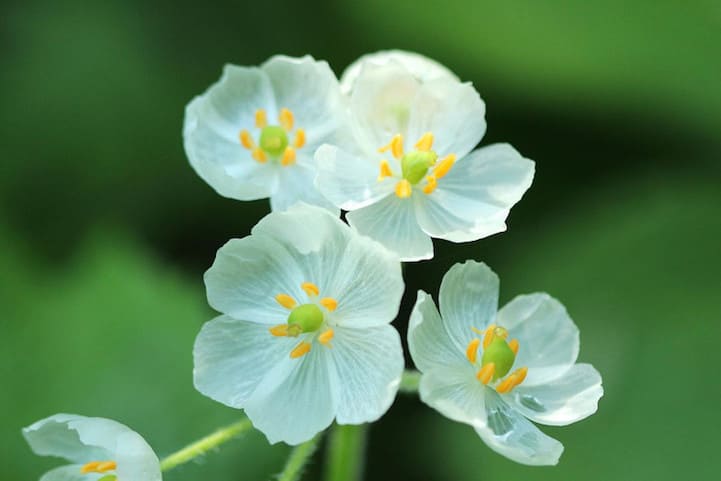Skeleton Flowers, known for their unique translucent petals, captivate plant enthusiasts with their ethereal beauty. Proper care is essential to ensure these delicate plants thrive. This comprehensive guide will provide detailed instructions on Skeleton Flower care, ensuring your plants remain healthy and vibrant.
Understanding the Skeleton Flower
The Skeleton Flower (Diphylleia grayi) is native to the mountainous regions of China and Japan. This perennial plant is notable for its white flowers, which become transparent when wet, creating a skeleton-like appearance. To cultivate these unique plants successfully, it is important to understand their natural habitat and replicate those conditions as closely as possible.
Optimal Growing Conditions
Light Requirements
Skeleton Flowers prefer partial to full shade, as direct sunlight can scorch their delicate petals. Ideally, they should receive filtered light through tree canopies or be placed in areas with dappled sunlight. If grown indoors, a north-facing window is ideal, or use sheer curtains to diffuse the light.
Soil Composition
The right soil mix is crucial for Skeleton Flowers. They thrive in moist, well-draining soil rich in organic matter. A mix of loamy soil with added compost or leaf mold works best. The pH level should be slightly acidic to neutral, around 6.0 to 7.0.
Watering Needs
Maintaining proper moisture levels is essential. Skeleton Flowers require consistent watering to keep the soil evenly moist but not waterlogged. Use a drip irrigation system or soaker hose to ensure deep watering without over-saturating the soil. In their natural habitat, these plants benefit from frequent misting, which helps maintain humidity and encourages the transparency of the petals.
Temperature and Humidity
Skeleton Flowers prefer cool to moderate temperatures ranging from 55°F to 75°F (13°C to 24°C). They thrive in environments with high humidity, mimicking their native mountainous habitats. If growing indoors, use a humidity tray or humidifier to maintain the desired humidity levels.
Planting and Propagation
Planting Skeleton Flowers
When planting Skeleton Flowers, choose a location that provides the appropriate light and moisture conditions. Dig a hole twice the size of the root ball and amend the soil with organic matter. Place the plant in the hole, ensuring the crown is level with the soil surface, and backfill with the amended soil. Water thoroughly to settle the soil around the roots.
Propagation Techniques
Skeleton Flowers can be propagated through division or seeds. Division is the most common method:
- Division: In early spring or fall, carefully dig up the plant and divide the rhizomes using a sharp knife. Ensure each division has at least one bud and several roots. Replant the divisions immediately and water well.
- Seeds: Collect seeds from mature plants in late summer. Sow seeds in a well-draining seed-starting mix and keep them moist. Germination can be slow, taking several weeks to months. Transplant seedlings into individual pots once they have developed a few sets of true leaves.
Ongoing Care and Maintenance
Fertilization
Skeleton Flowers benefit from regular feeding with a balanced, slow-release fertilizer. Apply fertilizer in early spring and again in midsummer to support growth and flowering. Avoid over-fertilizing, as this can lead to weak, leggy growth.
Pruning and Deadheading
Pruning is minimal for Skeleton Flowers. Remove spent flowers and yellowing leaves to maintain plant health and appearance. In late fall, cut back the foliage to the ground to prepare the plant for winter dormancy.
Pest and Disease Management
Skeleton Flowers are relatively pest-resistant, but they can occasionally suffer from slugs, snails, and aphids. Use organic pest control methods, such as neem oil or insecticidal soap, to manage infestations. Ensure good air circulation and avoid overwatering to prevent fungal diseases such as powdery mildew and root rot.
Seasonal Care
Winter Care
In colder climates, provide mulch around the base of the plant to protect the roots from freezing temperatures. Skeleton Flowers can withstand light frosts but may need additional protection during severe cold spells. If growing in containers, move the plants to a sheltered location or indoors during the winter months.
Spring Awakening
As temperatures warm in spring, remove the mulch and inspect the plant for new growth. Resume regular watering and fertilization to encourage robust growth. This is also the ideal time to divide and propagate the plants.
Common Issues and Solutions
Yellowing Leaves
Yellowing leaves can indicate overwatering or nutrient deficiencies. Check the soil moisture and adjust watering practices accordingly. Apply a balanced fertilizer to address potential nutrient imbalances.
Wilting or Drooping
Wilting or drooping leaves often result from insufficient water or excessive heat. Ensure the soil remains consistently moist and move the plant to a cooler, shaded location if necessary.
Poor Flowering
Lack of flowers can be due to inadequate light, poor soil conditions, or improper fertilization. Ensure the plant receives adequate filtered light and amend the soil with organic matter to improve fertility. Apply a balanced fertilizer to support flowering.
Conclusion
Caring for Skeleton Flowers requires attention to their specific light, water, soil, and humidity needs. By providing the right growing conditions and regular maintenance, you can enjoy the enchanting beauty of these unique plants year after year. With the proper care, your Skeleton Flowers will thrive, adding a touch of magic to your garden or indoor space.


